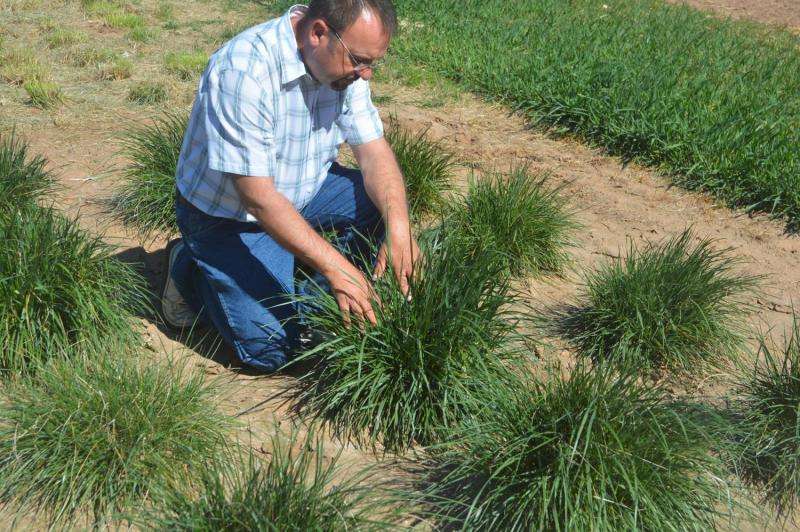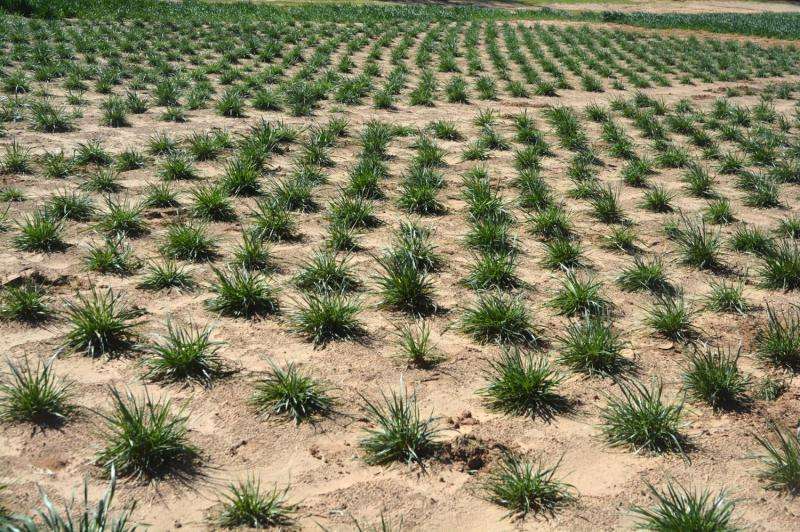Summer-dormant, cool-season grasses good option for perennial pastures

The past El Nino autumn and winter offered a good opportunity to establish pastures of summer-dormant tall fescue in Texas and Oklahoma, according to Dr. Dariusz Malinowski, a Texas A&M AgriLife Research forage agronomist and plant breeder in Vernon.
"A number of producers inquired about the availability of summer-dormant tall fescue seed last summer, and these producers had luck with stand establishment last autumn," Malinowski said. "The first growing season is the most critical to establish summer-dormant tall fescue pasture, and it looks like the weather has been cooperating so far."
For more than 10 years, he has been researching and evaluating a number of cool-season grasses originating from the Mediterranean Basin in environments with harsh summer droughts and mild winters, resembling Texas climate conditions.
These grass ecotypes possess a summer dormancy trait that allows them to survive six months without precipitation, in blistering heat, Malinowski said.
"There is no doubt in my opinion that summer-dormant cool-season grasses will be the only option for cool-season perennial forage for a long time, considering the climate projections for the Southern Great Plains."
He said climate change is projected to progress in the U.S. in the next couple of decades. The U.S. Global Change Research Program report predicts by the end of the century, the average U.S. temperature may increase by 4-6 degrees under the lower greenhouse gas emissions scenario or by 7-10 degrees under the higher emissions scenario.
Climate models suggest much of the Southeast and Southwest will become drier, especially in winter and spring, resulting in increased drought severity and duration, he said.
"These changes began taking place in Texas in the mid to late 1990's and have been progressing ever since," Malinowski said. "We all remember the devastating drought of 2011 in the Southern Great Plains, and 2015 had the highest average temperature ever recorded."
Producers rely on cool-season forages to sustain millions of grazing cattle each winter in this region, with wheat the major source of high-quality forage, he said. But abrupt patterns of autumn precipitation occurred quite often in the past years, delaying wheat planting and resulting in a lack of sufficient forage production.
"Producers are increasingly interested in planting perennial cool-season pastures that may serve as a complementary forage source to wheat or replace wheat grazing systems and balance the effects of weather extremes," Malinowski said.
Unfortunately, he said, most of the traditionally planted cool-season perennial forage grasses are now history in Texas and most of the Southern Great Plains because of their inability to cope with progressing aridity.
"We took the climate change predictions very seriously in the early 2000s, when I started to lead the forage systems program at Vernon," Malinowski said.
"Consequently, we initiated a collaborative research with Grasslands Innovation of New Zealand in 2008 to breed new cultivars of summer-dormant tall fescue, orchardgrass and perennial ryegrass with improved forage productivity and quality, and superior persistence."

He said several breeding lines are in the final stages of cultivar development and will be available to producers in the next few years.
Developing a new forage grass cultivar is not a fast track achievement.
"Similar to wheat, it takes about eight to 10 years to accomplish this goal," Malinowski said.
Meanwhile, producers have had a choice of two commercial cultivars of summer-dormant tall fescue in the U.S. – Flecha by Grasslands Innovation and Prosper by Barenbrug USA. In the past years, these cultivars were planted across Texas and Oklahoma and persisted well until the historic drought of 2011, he said.
"Repeated lack of precipitation during several subsequent winter growing seasons and the resulting inability to replenish resources exhausted the grass plants beyond their level of tolerance," Malinowski said.
There has been some concern the introduction of summer-dormant cool-season grasses to environments of the Southern Great Plains and the Mediterranean environments of California may result in these species becoming invasive to native flora, as was the case with summer-active tall fescue introduced to the U.S. in the 1800s, he said.
"Summer-dormant cool-season grasses, tall fescue in particular, are genetically and physiologically distinct from the summer-active variants; thus their potential to be invasive is not similar," Malinowski said.
Preliminary research suggests summer-dormant grasses originating from the Mediterranean Basin and introduced to Mediterranean-like environments of California have very limited potential for invasiveness when compared with introduced Mediterranean annuals and native summer-dormant grasses.
"Our data show that summer-dormant tall fescue is less competitive than continental tall fescue when both types were grown in binary mixtures with alfalfa, especially when constrained by low soil moisture availability in summer," he said.
In non-native environments such as those of the Southern Great Plains, summer-dormant tall fescue will not be able to take advantage of summer soil moisture, in contrast to native temperate and warm-season flora, because its growth pattern is highly restricted, Malinowski said.
"Summer-dormant cool-season grasses were introduced to southern Australia about 50 years ago and did not develop into environmental weeds," he said.
Malinowski said many producers also want to incorporate a forage legume crop to grow with summer-dormant tall fescue.
"In collaboration with Dr. Twain Butler of the Samuel Roberts Noble Foundation in Ardmore, Oklahoma, we evaluated the compatibility of a range of forage legumes, including alfalfa and annual medics. Annual medics, having a very similar growth pattern to summer-dormant tall fescue, were the most suitable to grow in mixed stands with summer-dormant tall fescue," he said.
Provided by Texas A&M University


















